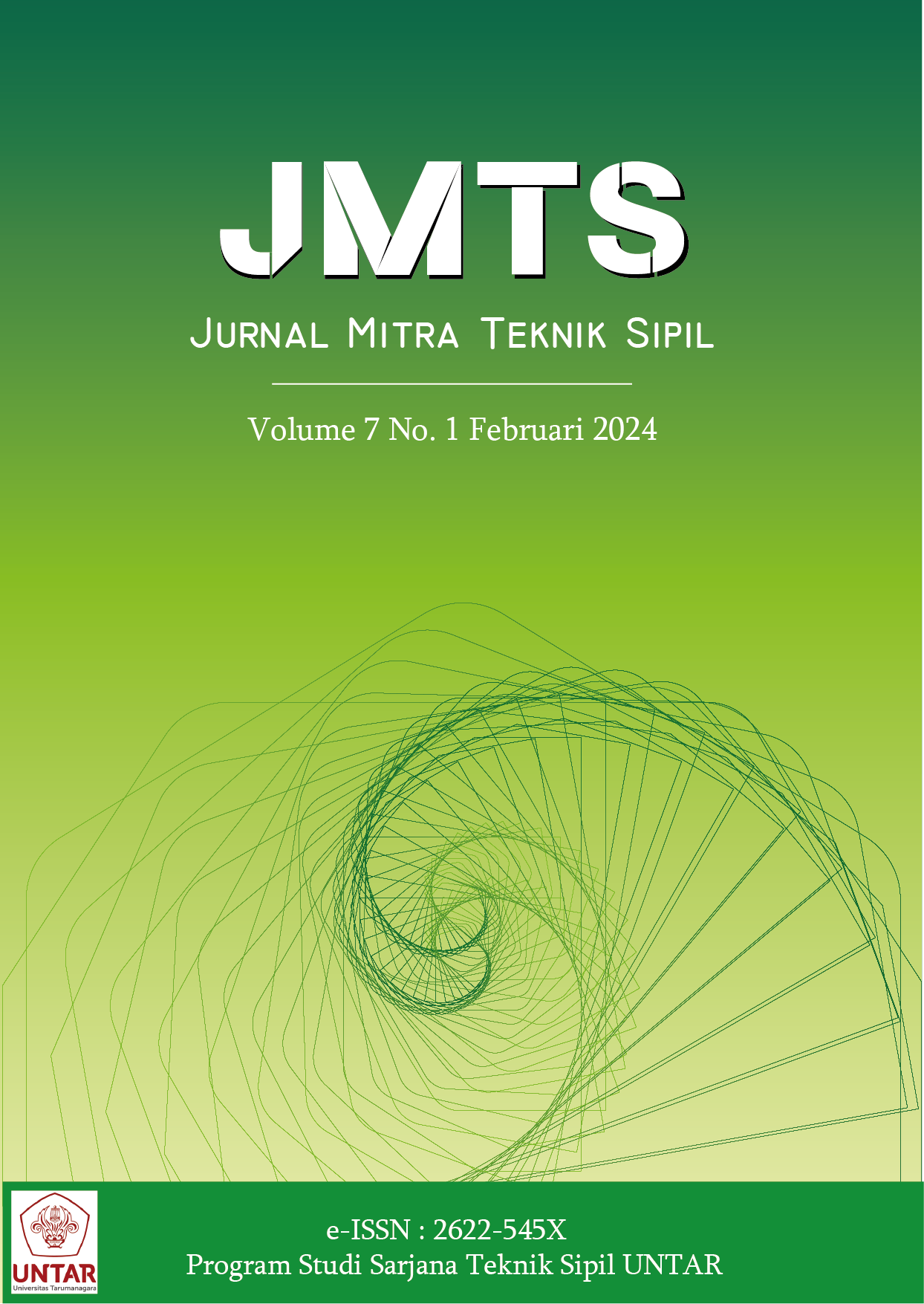PENINGKATAN KUAT TEKAN PADA BETON GEOPOLIMER AKIBAT METODE PERAWATAN DIPANASKAN
Main Article Content
Abstract
Studies about pozzolan material to reduce cement usage have been conducted for many times. Concrete made of pozzolan material was known as geopolymer concrete. Geopolymer concrete’s weaknesses were low duration of setting time and the low level of workability. The precast method was used to overcome these weaknesses. Concrete with a high initial compressive strength enable a more efficient implementation of the precast method due to it able to be released from the formwork without getting damaged. This study aims to see the increase in compressive strength due to the method of dry curing. In addition to that, differing from the geopolymer concrete without palm oil fuel ash, this study added 5% of palm oil fuel ash to see the effect of it on compressive strength. Constructed specimens were then cured at room temperature or heated in an oven with a temperature of 60°C for 24 hours. The ratio of alkaline activator to fly ash that were used in this research are 0,55:1 and 0,825:1. The specimen which was only a day old with 0,55:1 ratio experienced 2 times increase in compressive strength when being heated compared to the specimen cured at room temperature. The specimen which was of the same age with 0,825:1 ratio also experienced 3,5 times increase in compressive strength after being heated compared to those at room temperature. The increase of compressive strength was due to the heating process enabling the chemical reaction to occur faster.
Abstrak
Penelitian untuk memanfaatkan material pozzolan untuk mengurangi penggunaan semen sudah banyak dilakukan. Beton yang menggunakan material pozzolan disebut beton geopolimer. Kelemahan dari beton geopolimer adalah durasi setting time dan tingkat kelecakan yang rendah. Oleh karena itu, metode pracetak dapat digunakan untuk mengatasi kelemahan tersebut. Beton dengan kuat tekan awal yang tinggi dapat membuat metode pracetak semakin efisien karena beton dapat dilepaskan dari bekisting dan tidak rusak. Penelitian ini bertujuan untuk melihat peningkatan kuat tekan akibat metode perawatan benda uji dengan cara dipanaskan. Selain itu, pada penelitian ini ditambahkan abu cangkang kelapa sawit sebanyak 5% untuk dilihat pengaruhnya terhadap kuat tekan dibanding beton geopolimer tanpa abu cangkang kelapa sawit. Benda uji yang sudah dibuat, dirawat pada suhu ruangan atau dipanaskan pada oven dengan suhu 60°C selama 24 jam. Rasio alkali aktivator terhadap abu terbang yang digunakan pada penelitian ini adalah 0,55:1 dan 0,825:1. Hasil peningkatan kuat tekan yang didapat pada saat benda uji berumur 1 hari adalah benda uji dengan rasio 0,55:1 yang dipanaskan mengalami peningkatan kuat tekan sekitar 2 kali dan pada rasio 0,825:1 mengalami peningkatan kuat tekan sekitar 3,5 kali dibanding benda uji yang dirawat pada suhu ruangan. Hal itu disebabkan oleh pemanasan benda uji membuat reaksi kimia terjadi lebih cepat dan kuat tekan meningkat.
Article Details

This work is licensed under a Creative Commons Attribution-NonCommercial-ShareAlike 4.0 International License.
This work is licensed under Jurnal Mitra Teknik Sipil (JMTS) Creative Commons Attribution-ShareAlike 4.0 International License.References
Alfi, M. (2017). Studi penggunaan abu ampas tebu dan fly ash pada pasta geopolimer. Surabaya: Institut Teknologi Sepuluh Nopember.
Ali, K. A., Ahmad, M.I., & Yusup, Y. (2020). Issues, impacts, and mitigations of carbon dioxide emissions in the building sector. Sustainability, 12, 7427. https://doi.org/10.3390/su12187427
Amalo, P. S. (2018). Pengaruh parameter molaritas naoh, metode curing, dan bahan admixture terhadap kuat tekan dan workability beton geopolimer. Tangerang: Universitas Pelita Harapan.
Bediako, M., Gawu, S. K., Adjaottor, A. A., Ankrah, J. S., & Atiemo, E. (2016). Analysis of co-fired clay and palm kernel shells as a cementitious material in Ghana. Case studies in Construction Materials, 5, 46-52. http://dx.doi.org/10.1016/j.cscm.2016.06.001
Bhatt, A., Priyadarshini, S., Mohanakrishnan, A. A., Abri, A., Sattler, M., & Techapaphawit, S. (2019). Physical, chemical, and geotechnical properties of coal fly ash: A global review. Case Studies in Construction Materials 11. https://doi.org/10.1016/j.cscm.2019.e00263
Fernando, I. (2018). Pengaruh penggunaan abu sekam padi terhadap kuat tekan dan kuat lentur beton geopolimer. Tangerang: Universitas Pelita Harapan.
Hardjito, D. & Rangan, B. V. (2005). Development and properties of low-calcium fly ash-based geopolymer concrete. Australia: Curtin University of Technology.
Hasnaoui, A., Ghorbel, E., & Wardeh, G. (2019). Comparison between Portland cement concrete and geopolymer concrete based on metakaolin and granulated blast furnace slag with the same binder volume. Academic Journal of Civil Engineering, 37(2), 127-132. https://doi.org/10.26168/icbbm2019.18
Mulyati & Arkis, Z. (2020). Pengaruh metode perawatan beton terhadap kuat tekan beton normal. Jurnal Teknik Sipil ITP, Vol. 7, No. 2. https://doi.org/1 0.21063/JTS.2020.V702.05
Putra, A. F. K., Hasyim, S., Nurjannah, S. A., Usman, A. P., Hanafiah, H., & Juliantina, I. (2021, July). The properties of palm oil fuel ash-fly ash based geopolymer mortar. In AIP Conference Proceedings (Vol. 2347, No. 1). AIP Publishing. https://doi.org/10.1063/5.0051723
Salih, M. A., Demirboga, R., Ali, A. A. A., & Abdullah, M. M. A. B. (2013). Properties of fresh palm oil fuel ash based geopolymer material. Advances in Environmental Biology, 7(12), 3572-3579.
Serwinda, Hidayat, A., & Lumba, P. (2014). Pengaruh penambahan cangkang sawit terhadap kuat tekan beton f’c 25 MPa. Jurnal mahasiswa teknik, Universitas Pasir Pengairan.
Sodiqovna, O. M. & Orifjon qizi, I. G. (2020). The rate of a chemical reaction and factors affecting it. EPRA International Journal of Research and Development, Vol. 5, issue 8. https://doi.org/10.36713/epra2016
Susanto, J. (2020). Pengaruh pengunaan superplasticizer terhadap workability dan kuat tekan beton geopolimer. Tangerang: Universitas Pelita Harapan.
Vitri, G., & Herman, H. (2019). Pemanfaatan Limbah Kelapa Sawit Sebagai Material Tambahan Beton. Jurnal Teknik Sipil Institut Teknologi Padang, 6(2), 78-87. https://doi.org/10.21063/JTS.2019.V602.06
Yanuari, R., Ikrammullah, M., Septari, D., Wijaya, M. F., & Olivia, M. (2020). Studi parametrik mortar geopolimer hybrid abu sawit (palm oil fuel ash/POFA). Rekayasa sipil, 14(2), 83-90. https://doi.org/10.21776/ub.rekayasasipil.2020.014.02.1
Yasin, A. K., Bayuaji, R., & Susanto, T. E. (2017, November). A review in high early strength concrete and local materials potential. In IoP Conference Series: Materials Science and Engineering (Vol. 267, No. 1, p. 012004). IOP Publishing. https://doi.org/10.1088/1757-899X/267/1/012004
Yuliana, R., Muhardi, & Fatnanta, F. (2014). Karakteristik fisis dan mekanis abu sawit (palm oil fuel ash) dalam geoteknik. Jurnal online mahasiswa fakultas teknik Universitas Riau, 1(1), 1-13. https://jom.unri.ac.id/index.php/JOMFTEKNIK/article/view/3760



